Specialized Transition Pro (2011)
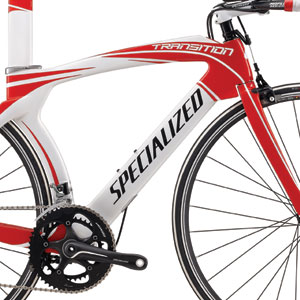
This bike is further evidence that the most hotly contested price category in tri bike land is the $3300 to $3700 range. The big boys—Trek, Cervelo, Felt, Cannondale, Scott—have gone all-in here. How does the Transition Comp fair? Quite well.
And we'll get to that. But first—you know the routine around here—we're going to separate who should and shouldn't be looking at this bike based on how it fits.
This bike is going to fit a lot of people. But it's also going to be a tough fit for a lot of other people, because of how it's spec'd, and because of how it's set up. This, unless the spec is changed at the point of sale for each individual customer. That's a problem at the $1500 complete bike level. But this bike is much more uptown than that, so, changing some spec is possible—maybe even expected—at this price point.
Geometry
First, let's talk about who it's going to fit. The molds were changed a bit between 2009 and 2010, a size was added at the small end of the scale (XS), a taller size (XXL) was made at the large end of the scale, and the XL was reworked. Now you have a full-fledged, 6-size, run of very nice frames. The grading among the sizes became truer, that is, each size was a similar thematic representation of the sizes adjacent to it.
As a result of the changes from 2009 to 2010, the Transition began to take on a style, and, that style is "narrow and tall." Now, it's not the narrowest, tallest bike out there. Still, it's marginally narrower/taller than the median bike (and the median might be Trek's Speed Concept, or maybe Cervelo's P2).
An example of narrow/tall among the major tri bike makers is Scott. But if you look at its Plasma 2 frame right in the middle of the side run (size M), it has a stack and reach of 52.7cm and 40.4cm respectively. Compare that to the Transition in size L, you get 52.6cm and 40.4cm. I know, I'm comparing one size to another. Still, these are geometrically identical bikes, and reinforces your need to rely on a rational sizing scheme, rather than on t-shirt sizing.
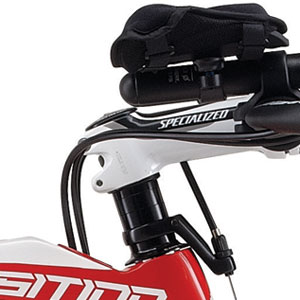
The point is that the Transition is a mostly narrow/tall bike, and the two sizes below the Transition's size L correspond almost exactly to the two sizes below the Plasma's size M.
This means the Transition should rarely, in my view, be set up like it is in the photo adjacent, which is the photo that Specialized uses when it displays this bike on its website. If you need a Transition to be set up this tall in front, your position is not going to look like very many among the reasonably hard core time trialists and triathletes (pro or age group). Best reconsider your position or maybe, even, your positioner. Ask him why your position is so tall on an already tall frame with high-profile aerobars. Maybe there's a good answer for this in your case, but, all the same, ask to hear that good answer.
Since this bike is set up to cater to the taller, narrower, position, it's ripe for a "flatenning" of the position. One of the elements of this frame I like is that, for a bike with a non-integrated, fully modular front-end, it has a sunken head tube top behind which the top tube resides. This intuitively seems to give the stem the ability to hide in front of the frame's top tube (does that makes any sense?).
Now, this being the case, if the stem is pitched up above the top of the top tube (as it is in this graphic) you lose that feature, do you not?
For this reason, if I were to buy this bike, I'd immediately ditch the original equipment headset top cap and front brake casing stop and replace them with a non-O.E., but available, headset top cap featuring an integrated casing stop. The total height of this piece is 5mm, and, this gives the stem (and I'd probably end up replacing the O.E. stem with one having a horizontal pitch) a fighting chance of sitting at least partly in that notch Specialized has created for it. If I was a Specialized retailer planning on selling a lot of Transitions, I'd immediately order a minimum of two dozen of this integrated top cap + casing stop.
Employing this piece also, by the way, allows me to more easily buy a frame based on the length of the Transition I need—the tallness of the Specialized frame is softened by my ability to lower the front end to match my fit coordinates. If you need the taller front-end config, with the angled-up stem, fine. Just, these sorts of maneuvers I'm recommending allow the Transition to very nicely fit riders of my ilk.
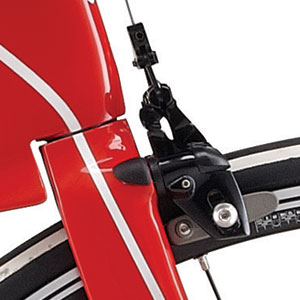
This means that you might buy a Transition in a size larger than you otherwise might, in order to get a frame the length you need, and to get more frame "underneath" you (paying for frame under your stem instead of paying for several headset spacers under your stem).
I, for example, at 6'2", am moderately tall, I but I ride slightly shorter than my overall height, because my saddle height is about 78cm (bottom bracket to saddle top). My saddle height is probably no greater (or not much greater) that Chris McCormack's. Yet, while Chris has variously ridden both a Transition in size M and an L, I'd certainly ride an XL. (I don't know what size Chris is riding these days, and he may be on a Shiv rather than a Transition).
So don't let the t-shirt sizing on this bike throw you. Get the size Transition that fits you, and, don't worry if the name Specialized attaches to the size is larger than you think you should ride—such t-shirt sizing is arbitrary and imprecise.
Handling
First may I state that I have no quarrel whatsoever with the handling of this bike in my size, nor in the size larger than the size I would ride. The bikes are very stable while riding in the aero position—more stable, better conceived, than plenty of the bikes in their competitive set.
The two middle sizes, M and L, are likewise nice handling, stable bikes, though they might err slightly on the side of too stable for those who're used to a more sprightly handler.
I have a gentle disagreement with the folks at Speciaized about the S and especially the XS. When you get into the real arcanities of bike (or motorcycle) design, you come across the term "trail" and its various iterations: mechanical trail, and dynamic trail. Specialized (in the person of the chief designer of Specialized's timed race bikes) has told me he thinks that trail is less important than I think it is, and that mechanical trail is what matters. Other bike companies' designers disagree, notably those from Cervelo (and Trek as well, judging by the geometries throughout the Speed Concept's size run). For these companies, trail is an input, that is to say, their tri bikes all appear to have a trail number hovering around 60mm or 61mm, in every size, by design.
The Transitions exhibit trail numbers in this range (slightly below to slightly above) from the M thru the XXL. But trail increases to 68mm and 74mm respectively in their S and XS sizes. It's going to have to be demonstrated to me that a tri bike with a trail of 74mm is a good handler, in a size where the front/center is 15mm longer than just about every bike, in this size, in its competitive set.
Mind, I understand Specialized' thinking: if you're going to make a bike that small with 700c wheels, you've got design problems to overcome: You need to make an appropriately narrow cockpit while navigating around shoe overlap problems. And that's why I think the XS just ought to be built in a 650c size. Finally Cannondale decided to do this with its Slice, and 5'3" Mirinda Carfrae is reportedly over the moon with her new Slice, compared to the 700c version she rode last season. I'd love to see a Transition in 650c.
But let's not haggle unduly. Four of the six Transition sizes are certainly ready for prime time, we'll just agree to disagree over the XS, and I'll remain an agnostic for now about size S.
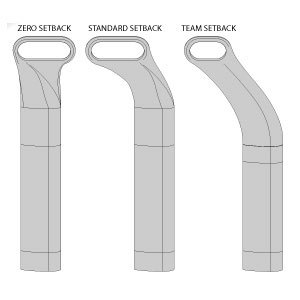
Other notable frame features
Let's wrap up with a few notes about additional things I like about this frame.
All Transitions built around this frame style come with any of three seatposts. These posts are named Team (way set back, without very much difference between its two fore and aft positions); the Regular post; and the Straight post. These posts are each two-position posts, and, on the straight post, the center of the binder mechanism sits either 100mm behind the BB or 150mm behind the BB depending on whether the binder mechanism is in its fore or aft position.
The offsets are rational and thought-out. The swept back post (Regular post) has offsets of 160mm and 210mm. The Team post has offsets of 200mm and 225mm respectively.
Your safest bet is to get your Transition with a Straight post (you may well choose the rear position of the Straight post). But if you're a taller rider—riding the XL or XXL—you might need the Regular post, with the moderate backsweep. This, because the seatpost sticks straight up, at 90°, so, the taller the bike size, the nominally steeper the bike is already.
The seat posts are also notable in that they don't slide down during riding. Place this frame in the category of those where you tighten the binder, and, done. Your post is fixed in place.
Finally, the Transitions are built to accept BB30 bottom brackets. This is just a better standard.
Gruppo
As regards drivetrain, Specialized is breaking free of the pack in this price category. While the other bikes in the Transition Pro's price range are spec'ing Ultegra, the Comp specs SRAM. Felt's B12 is the other notable bike in the mid-$3000s spec'ing SRAM.
Felt is notable for routinely winning the spec war against every other company. Unless your frame is a wire coat hanger, on which are hung derailleurs, cranks and a saddle, Felt is going to outspec you.
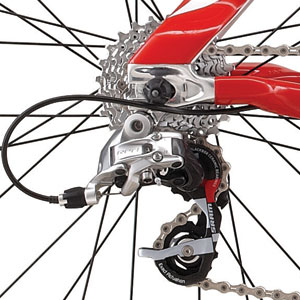
More precisely, Felt realizes that derailleurs are a bike's chest and derriere: These are the places your eyes immediately go. So they whip you right there—they outsex you with derailleurs you can't afford to spec.
Accordingly, on its B12, Felt comes right at you with SRAM Red front and rear derailleurs. But Specialized is prepared to take that punch—almost. It specs SRAM Force on the front, and Red on the rear. Each company then diverges and tries to save money where it can on brake calipers, cranks, and so forth but, the point is, Specialized came out to play in this category.
The question is whether this $3600 bike is a safer, better spec bet than the $3000 Transition Expert, spec'd with Ultegra pretty much throughout the drivetrain? Is a Specialized Pro FACT Carbon crankset (spec'd on this $3600 bike) really a better crankset than a Shimano Ultegra (spec'd on the $3000 Expert)? I don't know. Is the KMC X10 CP chain spec'd on this $3600 bike better than the Ultegra chain spec'd on the bike costing $600 less? I don't know, but it might even be a downspec.
Plainly put, I like this $3600 Transition Pro a lot. But if I were a Specialized retailer, I'd probably invest more heavily in the Transition Expert (to be reviewed later), that will likely fly out the doors of my retail store, while the Pro will (I predict) sell at a rate more leisurely versus the red hot Transition Expert.
That established, I don't like the aerobar spec on either of these models of Transition. The Profile Design T2 has aerobar pads too tall for this already tallish frame geometry, and the "+" extensions are a proper spec for a $1500 complete bike, not a $3600 complete bike.
But, no worries, I never consider bikes and aerobars joined at the hip anyway. In fact, at this price point, it would be a freakish coincidence if the bike I bought went out the door with the bar spec'd O.E.
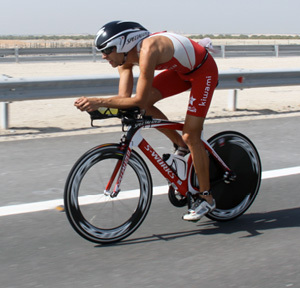
I don't mean that with regard to Specialized tri bikes, rather with any complete tri bike. Just, Specialized somewhat reduced the likelihood of that freakish circumstance occurring with the bar it chose to spec. Better for Specialized to do what Cannondale did, as it moved from 2010 to 2011: Pair this tallish-geometry frame with a less-tallish geometry aerobar. C'dale is now spec'ing Visiontech on its Slice (it spec'd Profile T2 last year), and Visiontech would've been a better spec choice for these Transitions.
Specialized is noted for having a very formidable "house brand" of saddles. As with cycling shoes and helmets, the Specialized brand stands alongside other specialty saddle, helmet and footwear makers as an equal. That noted, I'm not sure the Tri Tip saddles Specialized makes are ready to be considered the equal of tri saddles made by Cobb, Fizik, Selle Italia, Profile Design, and others. I don't say this because of my own experience with Tri Tip saddles, rather I haven't yet found that vocal set of Tri Tip champions.
Do not leave the store with your Transition unless you're happy with the saddle, and, notwithstanding this company's fine saddle tradition it's creating, if your choice is between a Speciaiized saddle and another Specialied saddle, stand firm. This, unless you're hiked over, back flat, laid out on the aerobars, and your bummy's chummy with a saddle on which is emblazened the Big Red S.
Final impressions
All in all, Specialized has done a great job with the Transition. There are points of disagreement I have with Specialized, as I've noted. I'd like the company to spec its front ends a bit differently (but I write this about a lot of bike companies). And I wish it would make a 650c bike for its smallest customers. Otherwise, the Transition is a heck of a bike. Its proprietary brakes are a slight bit ornery in their adjustment, but, their center pull designs are a big step up from those bike companies that rely on the side-pull Tektros underneath the chain stay and behind the fork crown, both in aerodynamics and in adjustability.
The prices Specialized are asking for their complete Transitions are more than fair. My one concern about the this model that overarches the entire size run is that I'm afraid the Transition Expert might place significant pressure on the Transition Pro.
All Transitions for 2011 should be hitting showroom floors mid-October of 2010.


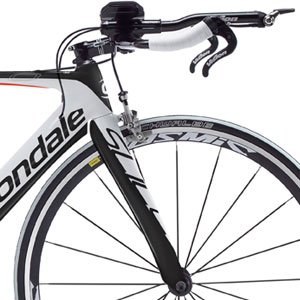
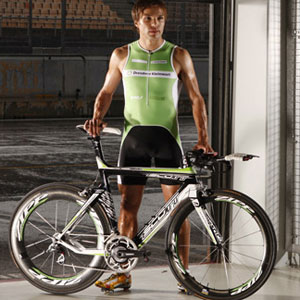
Start the discussion at slowtwitch.northend.network